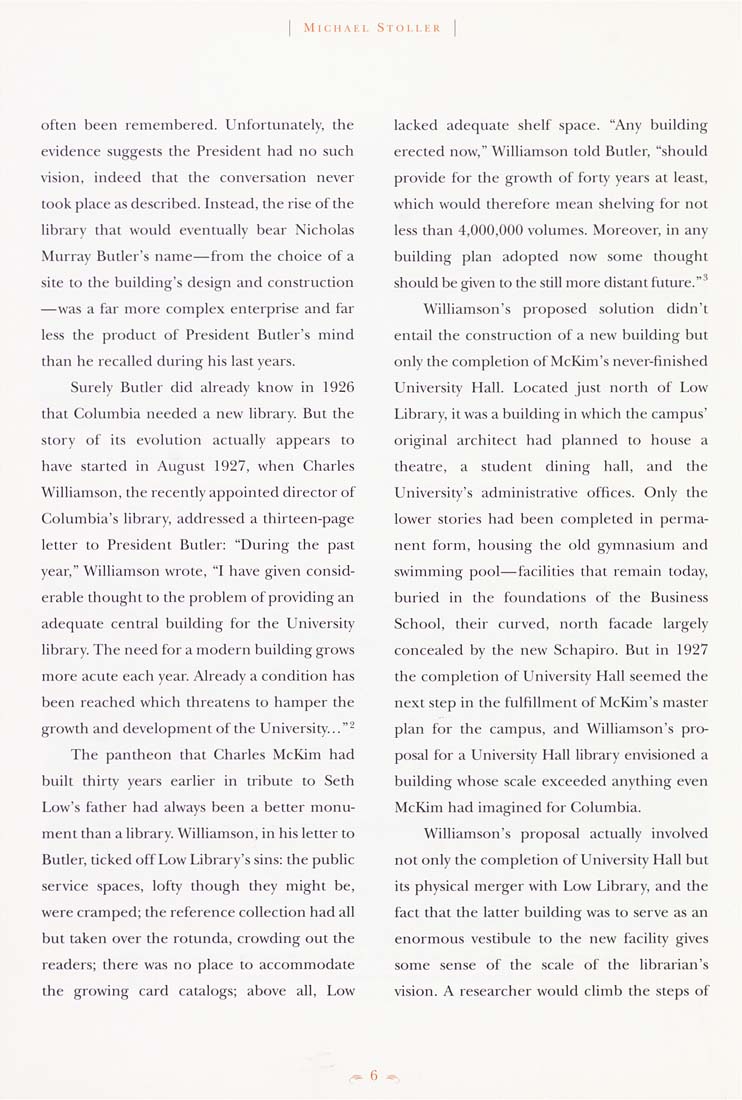Columbia Library columns (v.45(1996))
(New York : Friends of the Columbia Libraries. )
|
||
|
|
|
|
| v.45,no.2(1996:Autumn): Page 6 |

I Michael Stoller often been remembered. Unfortunately, the evidence suggests the President had no such vision, indeed that the conversation never took place as described. Instead, the rise of the library that would eventually bear Nicholas Murray Butler's name—from the choice of a site to the building's design and construction —was a far more complex enterprise and far less the product of President Butler's mind than he recalled during his last years. Surely Butler did already know in 1926 that Cohunbia needed a new library. But the story of its evoludon actually appears to have started in August 1927, when Charles Williamson, the recently appointed director of (k)lumbia's library, addressed a thirteen-page letter to President Butler: "During the past year," Williamson wrote, "I have given consid¬ erable thought to the problem of providing an adequate central building for the University library. The need for a modern building grows more acute each year. Already a condition has been reached which threatens to hamper the growth and development of the University..."- The pantheon that Charles McKim had built thirty years earlier in tribute to Seth Low's father had always been a better monu¬ ment than a library. Williamson, in his letter to Butler, ticked off Low Library's sins: the public service spaces, lofty though they might be, were cramped; the reference collection had all but taken over the rotunda, crowding out the readers; there was no place to accommodate the growing card catalogs; above all, Low lacked adequate shelf space. "Any building erected now," Williamson told Butler, "should provide for the growth of forty years at least, which would therefore mean shelving for not less than 4,000,000 volumes. Moreover, in any building plan adopted now some thought should be given to the sdll more distant future."^ Williamson's proposed solution didn't entail the construction of a new building but only the completion of McKim's never-finished University Hall. Located just north of Low Library, it was a building in which the campus' original architect had planned to house a theatre, a student dining hall, and the University's administrative offices. Only the lower stories had been completed in perma¬ nent form, housing the old gymnasium and swimming pool—facilities that remain today, buried in the foimdations of the Business School, their curved, north facade largely concealed by the new Schapiro. But in 1927 the completion of University Hall seemed the next step in the fulfillment of McKim's master plan for the campus, and Williamson's pro¬ posal for a University Hail library envisioned a building whose scale exceeded anything even McKim had imagined for Columbia. Williamson's proposal actually involved not only the compledon of University Hall but its physical merger with Low Library, and the fact that the latter building was to serve as an enormous vestibule to the new facility gives some sense of the scale of the librarian's vision. A researcher would climb the steps of |
| v.45,no.2(1996:Autumn): Page 6 |







